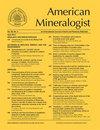Two modes of terrestrial phosphide formation
IF 2.7
3区 地球科学
Q2 GEOCHEMISTRY & GEOPHYSICS
引用次数: 0
Abstract
In anorthite-diopside-tridymite paralava of the Hatrurim Complex, Daba-Siwaqa, Jordan, phosphides from two facies environments were found. Large xenomorphic phosphide aggregates, presented by minerals of the barringerite-transjordanite series, murashkoite and zuktamrurite, were noted at the intimate contact of the paralava with the host rocks. Moreover, the contact facies of the paralava, composed of large diopside crystals up to 1 cm in size and cemented by hydrosilicates, zeolites and calcite, are enriched in phosphides. In the contact facies, it was possible to observe pseudomorphs of barringerite and murashkoite after fish bones and inclusions of minute needle-like barringerite crystals in diopside with morphological manifestations of the simultaneous crystallization of these minerals. In the central part of the weakly altered paralava with abundant amygdules, two nodules containing ore minerals were detected. In the first nodule, barringerite and schreibersite were found; the second contained nickelphosphide. In this paper we discuss the hypothesis that phosphides at the contact facies of the paralava formed as a result of reducing carbothermal reactions with the participation of thermally altered and graphitized fish-bone remains as a source of carbon and phosphorus and oxidised pyrite framboids as an iron source: Fe2O3 + 3C = 2Fe(lq) + 3CO(g), 2Ca5(PO4)3F + 14C = 3P2(g) + 14CO(g) + 10CaO + F2(g) and nFe(lq) +1/2P2(g) = FenP, where n = ½, 1, 2, 3. The process of phosphide formation during hot paralava injection, the temperature of which exceeded 1400°C, into previously altered host rocks with contamination of material containing bone remains, took place in a small volume in a kinetic mode, which led to the preservation of the primary form of bone remains when they were replaced by phosphides. The formation of phosphides in the central part of the paralava occurred with the participation of gases that transported phosphorus reduced as a result of carbothermal reactions. The phosphorous was absorbed by drops of metal or sulphide melt, which led to the formation of phosphides.陆地磷化物形成的两种模式
在约旦 Daba-Siwaqa 的 Hatrurim 复合体的阳起石-透辉石-菱锰矿辉绿岩中,发现了来自两种岩相环境的磷化物。在副熔岩与主岩的紧密接触面上发现了大型异形磷化物聚集体,由巴林石-透闪石系列矿物、Murashkoite 和 Zuktamrurite 组成。此外,副熔岩的接触面由大小达 1 厘米的大型透辉石晶体组成,由水硅酸盐、沸石和方解石胶结,富含磷酸盐。在接触面中,可以观察到鱼骨状的巴林石和黝帘石假象,以及透辉石中微小的针状巴林石晶体包体,这些矿物同时结晶的形态表现。在具有丰富杏仁体的弱蚀变副熔岩中部,发现了两个含有矿石矿物的结核。在第一个结核中,发现了巴林石和施雷伯石;第二个结核中含有镍磷矿。本文讨论的假设是,副熔岩接触面的磷化物是还原碳热反应的结果,热蚀变和石墨化的鱼骨残骸是碳和磷的来源,氧化黄铁矿框架体是铁的来源:Fe2O3 + 3C = 2Fe(lq) + 3CO(g), 2Ca5(PO4)3F + 14C = 3P2(g) + 14CO(g) + 10CaO + F2(g) 和 nFe(lq) +1/2P2(g) = FenP,其中 n = ½, 1, 2, 3。在温度超过 1400 摄氏度的热熔浆喷入先前被含有骨骸物质污染的蚀变主岩过程中,磷化物的形成过程是在小体积内以动力学模式进行的,当骨骸被磷化物取代时,骨骸的主要形态得以保留。磷化物在岩浆岩中部的形成是在碳热反应产生的磷还原气体的参与下发生的。磷被金属或硫化物熔滴吸收,从而形成磷化物。
本文章由计算机程序翻译,如有差异,请以英文原文为准。
求助全文
约1分钟内获得全文
求助全文
来源期刊

American Mineralogist
地学-地球化学与地球物理
CiteScore
5.20
自引率
9.70%
发文量
276
审稿时长
1 months
期刊介绍:
American Mineralogist: Journal of Earth and Planetary Materials (Am Min), is the flagship journal of the Mineralogical Society of America (MSA), continuously published since 1916. Am Min is home to some of the most important advances in the Earth Sciences. Our mission is a continuance of this heritage: to provide readers with reports on original scientific research, both fundamental and applied, with far reaching implications and far ranging appeal. Topics of interest cover all aspects of planetary evolution, and biological and atmospheric processes mediated by solid-state phenomena. These include, but are not limited to, mineralogy and crystallography, high- and low-temperature geochemistry, petrology, geofluids, bio-geochemistry, bio-mineralogy, synthetic materials of relevance to the Earth and planetary sciences, and breakthroughs in analytical methods of any of the aforementioned.
文献相关原料
| 公司名称 | 产品信息 | 采购帮参考价格 |
|---|
 求助内容:
求助内容: 应助结果提醒方式:
应助结果提醒方式:


